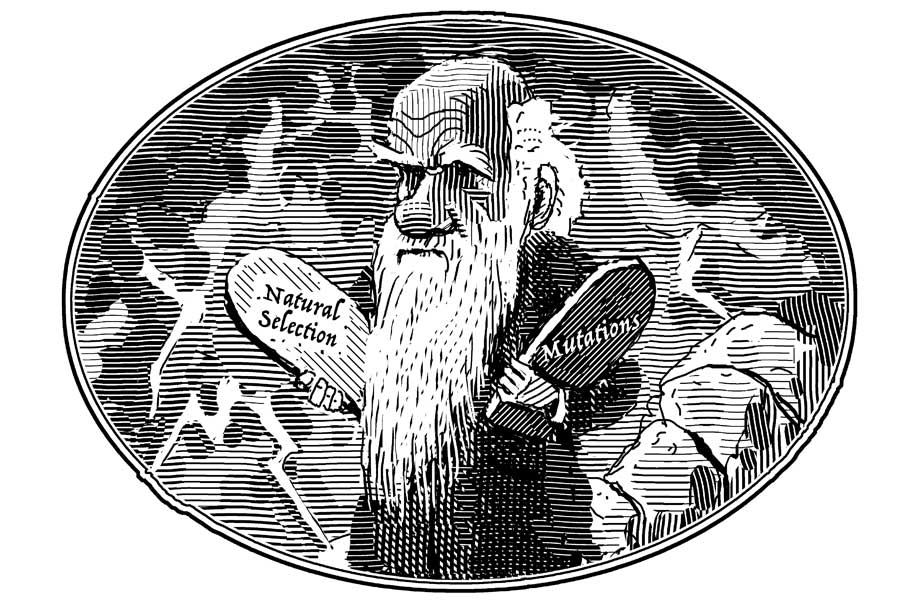Giving Up On Darwin
Perhaps the most remarkable book I have read in recent years is the one that is the main subject of this superb review by Yale’s own David Gelernter (one of my heroes). Below is an excerpt but, (as they say) read the whole thing.
I wish Clement Markert were still here to discuss this. The last conversation I had with him (at his place in the Sangre de Cristo Range, in 1997) was on new Darwinism.
— Jamie Woolery
Darwinian evolution is a brilliant and beautiful scientific theory. Once it was a daring guess. Today it is basic to the credo that defines the modern worldview. Accepting the theory as settled truth—no more subject to debate than the earth being round or the sky blue or force being mass times acceleration—certifies that you are devoutly orthodox in your scientific views; which in turn is an essential first step towards being taken seriously in any part of modern intellectual life. But what if Darwin was wrong?
Like so many others, I grew up with Darwin’s theory, and had always believed it was true. I had heard doubts over the years from well informed, sometimes brilliant people, but I had my hands full cultivating my garden, and it was easier to let biology take care of itself. But in recent years, reading and discussion have shut that road down for good.
This is sad. It is no victory of any sort for religion. It is a defeat for human ingenuity. It means one less beautiful idea in our world, and one more hugely difficult and important problem back on mankind’s to-do list. But we each need to make our peace with the facts, and not try to make life on earth simpler than it really is.
Charles Darwin explained monumental change by making one basic assumption—all life-forms descend from a common ancestor—and adding two simple processes anyone can understand: random, heritable variation and natural selection. Out of these simple ingredients, conceived to be operating blindly over hundreds of millions of years, he conjured up change that seems like the deliberate unfolding of a grand plan, designed and carried out with superhuman genius. Could nature really have pulled out of its hat the invention of life, of increasingly sophisticated life-forms and, ultimately, the unique-in-the-cosmos (so far as we know) human mind—given no strategy but trial and error? The mindless accumulation of small changes? It is an astounding idea. Yet Darwin’s brilliant and lovely theory explains how it could have happened.
Its beauty is important. Beauty is often a telltale sign of truth. Beauty is our guide to the intellectual universe—walking beside us through the uncharted wilderness, pointing us in the right direction, keeping us on track—most of the time.
There’s no reason to doubt that Darwin successfully explained the small adjustments by which an organism adapts to local circumstances: changes to fur density or wing style or beak shape. Yet there are many reasons to doubt whether he can answer the hard questions and explain the big picture—not the fine-tuning of existing species but the emergence of new ones. The origin of species is exactly what Darwin cannot explain.
Stephen Meyer’s thoughtful and meticulous Darwin’s Doubt (2013) convinced me that Darwin has failed. He cannot answer the big question. Two other books are also essential: The Deniable Darwin and Other Essays (2009), by David Berlinski, and Debating Darwin’s Doubt (2015), an anthology edited by David Klinghoffer, which collects some of the arguments Meyer’s book stirred up. These three form a fateful battle group that most people would rather ignore. Bringing to bear the work of many dozen scientists over many decades, Meyer, who after a stint as a geophysicist in Dallas earned a Ph.D. in History and Philosophy of Science from Cambridge and now directs the Discovery Institute’s Center for Science and Culture, disassembles the theory of evolution piece by piece. Darwin’s Doubt is one of the most important books in a generation. Few open-minded people will finish it with their faith in Darwin intact.





While reading about the successful exploits of Howorth and Briney in bridge tournaments around the world (see “Bridge” under Howorth’s page) I chanced a look at Woolery’s page. I read about Woolery’s passion for a book that he says demonstrates the difficulty of accounting for the problems of speciation and the sudden appearance of new species in the fossil record, among other arguments, that defied a mechanistic explanation for Darwin. With the caveat emptor that the book in Woolery’s sites was published in 2013 and my comments focus on Gould’s work from the 70’s, it was Woolery’s call to Clement Markert that sprung the wheels of thinking and remembering.
First, on Markert: Remember our time so colored with McNamara’s folly, better termed McNamara’s Lie thanks to Daniel Ellsberg (this said with grief stricken apologies to the brave Yale men, and others, who fought, especially our friend Biff McKellup and Jon Shine). Clement Markert was a hero of the first order for many of us – a warrior in the Lincoln Brigade, a refusnik during the McCarthy hearings, discoverer of the concept of iso-enzymes (I was told his auto license plate was written LDH-5), and a recent arrival in the biology department at Yale in the 60’s. Woolery and I had the good sense to take a senior (or was it junior?) seminar with Clem that focused on an article he had written that captured my imagination – about Malthus and populations and food and water supply. Well I spent the semester in near silent agony, wondering how anything I might possibly think or say that the great man hadn’t already thought about and dismissed. Woolery, the much better and more articulate student, had the intellectual heft to press an argument in the face of Markert’s furrowed brow.
And so now returning to the point, Woolery asks what would Clem Markert say. Well first he would read widely and wonder if Steven Jay Gould and a host of others – including Darwin – had not already grappled with the problem of gradualism and the stagnant fossil record. Gareth Cook in a piece in the New Yorker July 2, 2013 focuses on some of issues. Before getting technical, Clem and these others would say: if we cannot explain “it”, “it” need not be the work of a supreme deity. The (Walcott) Burgess shale explosion was not an explosion, and much of the taxonomy described, on modern analysis appears as simple evolving into more complex over 30M years (Marshall,C.R., (2006): AnnRevEPS 34:355). And for the problem of speciation see Steven Jay Gould (with Eldredge 1971 or 1972), the model employing punctuated equilibrium, spelled out in Neoteny and Heterochrony (1977) but including homogenizing effects of population size on gene flow, and more, in excruciating technical detail, in The Structure of Evolutionary Theory (2002). I am out of my depth now and admit to not following the arguments beyond the amazing SJ Gould, but also admit to the belief- maybe like Clem Markert – that the very essence of scientific enquiry is to reach an edge and admit ignorance and perform the next experiment or wait for technology in hardware or software to help focus the next question.
Do not give up Jamie!
Darwin’s theories were developed long before major breakthroughs in science, including understanding of DNA in the hereditary process. In a more recent work (2019), Darwin Devolves, Michael Behe explores major resulting vulnerabilities of some his theories.